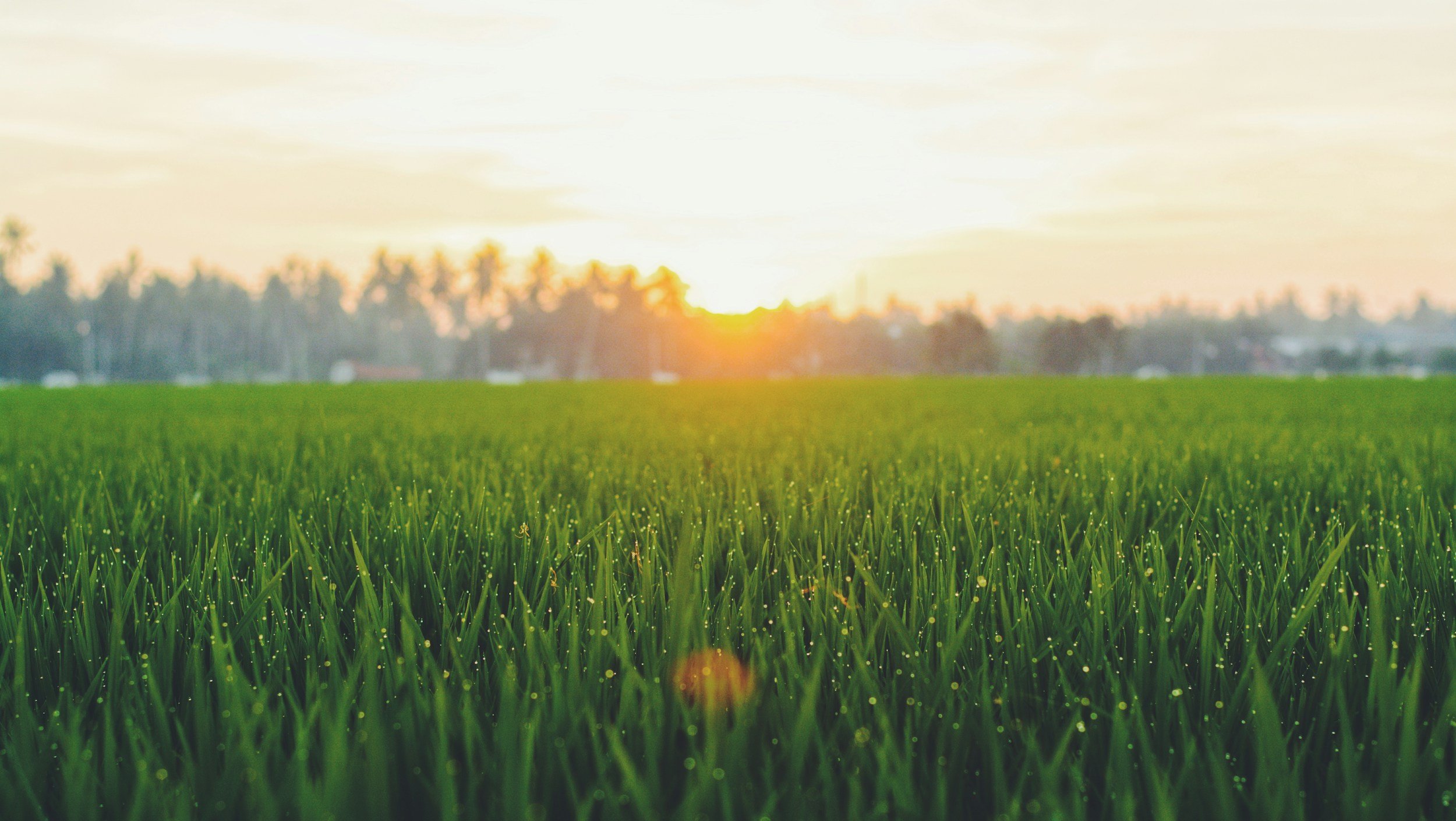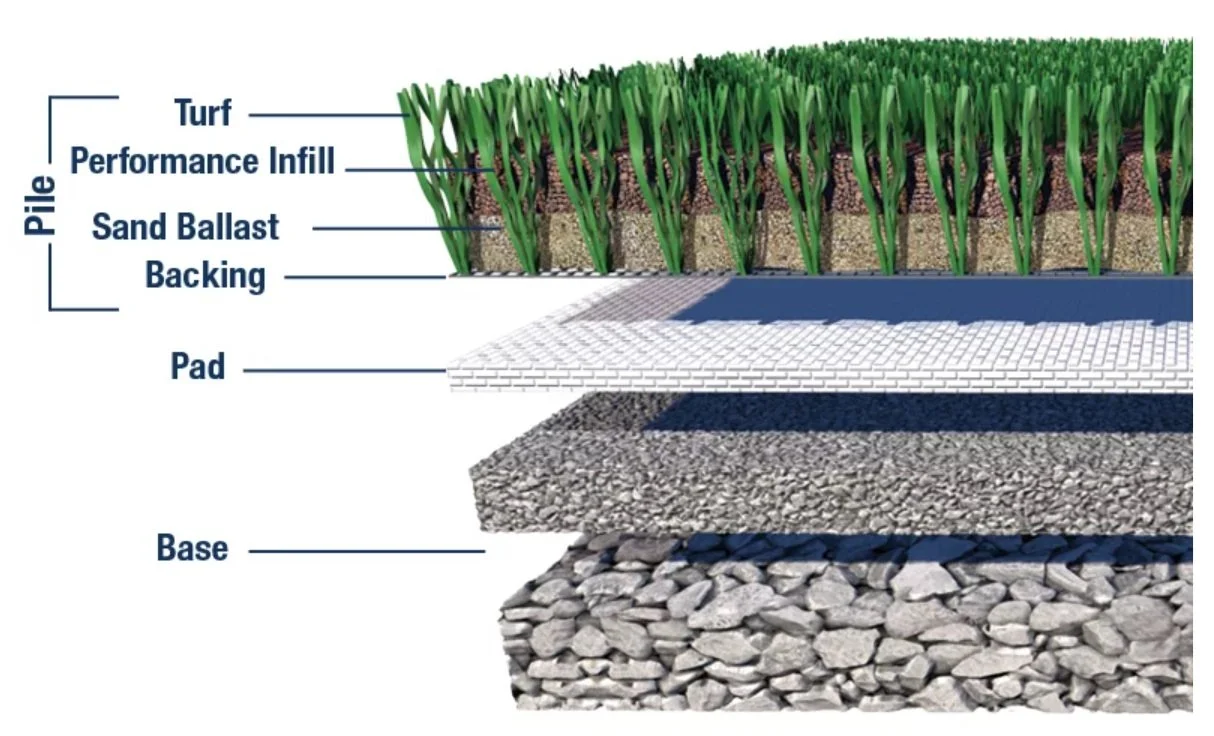
Turf Resources
Discover the advantages and drawbacks of natural grass, hybrid, and artificial turf fields.
NATURAL GRASS FIELD
A high quality, well maintained natural grass provides a great playing surface that is preferred by many athletes for its feel of play and reduced impact on the body. It also offers environmental benefits, such as cooling effects, carbon absorption, and improved air quality. However, natural grass requires significant maintenance, including regular watering, mowing, and fertilization, which can be costly and resource-intensive. Additionally, it is susceptible to weather conditions and heavy use, leading to muddy or uneven surfaces that can increase the risk of injury.
HYBRID TURF
Hybrid turf combines natural grass with synthetic fibers, offering a balance between the natural feel of grass and the durability of artificial turf. This type of surface provides the durability of full artificial turf while maintaining a high-quality playing field of a natural grass field. The surface can be played on the same as an artificial with better durability over the lifespan of the product. The product lifespan is indefinite, meaning you won’t have to replace it. It also requires less maintenance than natural grass but still needs watering, mowing, and occasional repairs. Hybrid turf is shaping the next generation of athletic fields.
ARTIFICIAL TURF- Why we don’t recommend
Artificial turf is highly durable and requires less maintenance compared to natural grass, making it a useful option for high-traffic areas. It is not affected by weather conditions, providing a consistent playing surface year-round. However, artificial turf typically has a lifespan of about 10 years, after which it needs to be replaced. It also becomes excessively hot in warm climates, leading to discomfort and potential health risks. Additionally, it lacks the natural cushioning of grass, which can increase the impact on players' joints and potentially raise the risk of injuries. Environmental concerns also arise from its production and disposal, as well as the lack of natural cooling effects found in grass.
NFL Artificial Turf Debate:
1. NFLPA's Advocacy for Natural Grass
NFLPA Calls for Elimination of Artificial Turf Fields to Avoid 'Unnecessary Injuries'
NFLPA Executive Director Lloyd Howell emphasized that 92% of NFL players prefer grass over turf, advocating for all stadiums to adopt natural grass surfaces. (Cronkite News)NFLPA President JC Tretter Calls for Replacement, Ban of Slit-Film Turf Fields
JC Tretter, NFLPA President, urged the NFL to ban slit-film turf due to safety concerns. (Bleacher Report)NFLPA Renews Call for Natural Grass to Help Prevent Injuries After Rodgers Gets Hurt
Following Aaron Rodgers' injury, the NFLPA reiterated the need for natural grass fields to enhance player safety. (AP News)
2. Injury Data and Player Preferences
92% of Players Prefer to Play on Grass Fields Over Turf
A significant majority of NFL players express a preference for grass fields, citing safety and performance benefits. (Bleacher Report)NFL Field Surface Dilemma Still a Concern as 2024 Season Approaches
Despite ongoing concerns about turf-related injuries, the NFL has not mandated a switch to grass fields. (Cronkite News)
3. NFL's Position and Initiatives
Rethinking Turf From The Ground Up
The NFL explores innovations in synthetic turf to improve safety and performance. (NFL.com)Grass or Turf? NFLPA Says World Cup Proves Moves Can Be Done
The NFLPA points to stadiums converting to grass for the World Cup as evidence that a league-wide shift is feasible. (Front Office Sports)
4. Scientific and Environmental Concerns
What Does the Science Say About the Grass vs. Turf Debate in Sports?
Studies show mixed results, but some indicate higher foot and ankle injury rates on artificial turf. (AP News)Athletes Likely to Have Higher Levels of PFAS After Play on Artificial Turf - Study
Research suggests that playing on artificial turf may expose athletes to higher levels of harmful chemicals. (The Guardian)
5. Legal and Public Advocacy
Turf Wars: The Courtroom Battle Over Artificial Turf Safety
Legal challenges arise concerning the safety of artificial turf and its implications for player health. (Reuters)Join NFL Players in Calling for an End to Artificial Turf
Public campaigns support the NFLPA's stance, urging a transition to natural grass fields. (Athletic Turf)
Artificial Turf Maintenance
Scientific studies have demonstrated that proper maintenance of artificial turf is essential for ensuring athlete safety and prolonging the lifespan of the playing surface. A comprehensive review published in Sports Health highlights that modern synthetic turf systems require routine maintenance to maintain optimal performance and safety standards. The study emphasizes that neglecting maintenance can lead to surface degradation, increasing the risk of injuries. SOURCE SOURCE
Research from Penn State University's Center for Sports Surface Research further supports the importance of maintenance. Their studies indicate that regular upkeep, such as infill topdressing and fiber grooming, is crucial to preserve the field's playability and safety. These maintenance practices help in managing surface hardness and traction, which are vital for athlete performance and injury prevention. SOURCE
Additionally, a study on university soccer players observed that the deterioration of artificial turf over time led to an increase in lower extremity muscle strains. However, after refurbishing the field with additional rubber infill, the incidence of such injuries significantly declined, highlighting the importance of timely maintenance in preserving field quality and safety. SOURCE
Injury Rates and Player Safety:
A study analyzing injury data from the National Football League (NFL) between 2012 and 2016 found a 16% higher incidence of foot and leg injuries per play on artificial turf compared to natural grass. The authors estimated that if all games had been played on grass during that period, there would have been 319 fewer such injuries. SOURCE
Similarly, research published in the American Journal of Sports Medicine indicated a higher rate of foot and ankle injuries on both old-generation and new-generation artificial turf compared to natural grass, while knee and hip injury rates were similar across both surfaces. SOURCE
These findings suggest that surfaces incorporating natural grass components, like hybrid turf, may offer safety benefits over fully artificial systems.
Environmental Impact:
A life cycle assessment conducted by the Zurich University of Applied Sciences compared various sports field surfaces, including natural turf, artificial turf, and hybrid systems. The study found that, per hour of use, natural turf had the lowest environmental footprint, followed by artificial turf without infill, and then artificial turf using infill materials like granulated rubber. However, due to its ability to withstand more hours of use, unfilled artificial turf often had the lowest environmental footprint in practice, as it reduced the total number of pitches required. The study recommended optimizing the use of existing pitches before constructing new ones and selecting the appropriate surface based on the expected intensity of use. SOURCE



